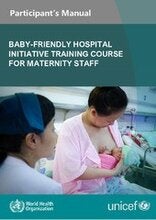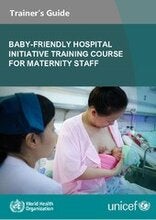Section Navigation
Poor nutrition during the early stages of the life course can lead to extensive and irreversible damage to physical growth and brain development. On the other hand, good nutrition has a positive effect. Breastfeeding is the optimal way of feeding babies, offering them the nutrients they need in the right balance, as well as providing protection against disease.
The World Health Organization recommends that babies be exclusively breastfed for the first six months of life, followed by the introduction of nutritionally adequate and safe complementary foods, and with continued breastfeeding up to two years old or beyond.
In 2012 the World Health Assembly (WHA) approved the global nutrition target of increasing the rate of exclusive breastfeeding in the first 6 months of age to at least 50% by 2025.
Breastfeeding helps prevent overweight and type-2 diabetes in children
Longer breastfeeding reduces the risk of overweight/obesity by 13%, helping to fight chronic diseases caused by obesity. It also lowers the risk of type 2 diabetes by 35%14.
Breastfeeding prevents childhood leukemia
Breastfeeding for more than 6 months or longer compared to no or shorter breastfeeding is associated with a reduction of childhood leukemia by 19%.
Breastfeeding protects against sudden infant death syndrome
Breastfed babies are 60 percent less likely to die from SIDS than those not breastfed. The effect is even more significant for infants exclusively breastfed.
Duration of breastfeeding is positively associated with higher income
A 30-year follow-up of a cohort captured at birth showed that adults who had been breastfed earned higher wages, an effect mediated through an increase in years of schooling.
Breastfeeding promotes attachment
Mother-child bonding is enhanced when mothers interact with their infants while breastfeeding. Longer breastfeeding is associated with more sensitive maternal responsiveness and the security that comes with attachment.
Workplace policies to support breastfeeding are good for business
Workplace policies in support of breastfeeding increase employee retention, performance, loyalty, productivity, and morale.
Breastfeeding makes babies smarter
Adults who were breastfed as children score 3.3 points higher on cognitive development indicators, which leads to more years of schooling.
Breastfeeding is good for the environment
Breastfeeding leaves no carbon footprint. Breast milk is renewable and produced and fed to the baby without pollution, packaging, or waste.
Breast milk: more than nutrition
Beyond providing perfect nutrition and protection against infection and death, constituents in breast milk likely affect epigenetic programming at a critical time when an infant’s gen expression is being developed for life.
Breastfeeding: a public health imperative
“If a new vaccine became available that could prevent 1 million or more child deaths a year, and that was moreover cheap, safe, administered orally, and required no cold chain, it would become an immediate public health imperative. Breastfeeding can do all this and more13.”
Breastfeeding protects women too
Women who breastfeed compared with women who don’t breastfeed or breastfeed less have a 32% lower risk of type 2 diabetes, a 26% lower risk of breast cancer, and a 37% lower risk of ovarian cancer.
Breastfeeding needs protection
The International Code of Marketing of Breast-milk Substitutes provides guidelines to prevent the inappropriate marketing of breastmilk substitutes, including infant formula, feeding bottles, nipples, follow-on milk, and related products16. It needs to be legislated and monitored. When manufacturers and distributors are in violation, they should be sanctioned.
Actions
To achieve the health and economic benefits of breastfeeding, investment in its protection, promotion, and support is needed. The Breastfeeding Advocacy Initiative led by WHO and UNICEF, in collaboration with other partners, calls upon governments, donors, and development partners to:
- Increase funding to reach the 2025 World Health Assembly Target to raise the rate of exclusive breastfeeding in the first 6 months to at least 50 percent.
- Fully implement the International Code of Marketing of Breast-milk Substitutes and subsequent relevant World Health Assembly Resolutions.
- Enact family leave and workplace breastfeeding policies.
- Implement the Ten Steps to Successful Breastfeeding in maternity facilities.
- Improve access to skilled lactation counseling.
- Strengthen links between health facilities and communities.
- Create monitoring systems that track the progress of policies, programs, and funds toward achieving both national and global breastfeeding targets.
PAHO provides technical support to countries in implementing the Baby-friendly Hospital Initiative (BFHI) on a national level, reporting on monitoring of the International Code, and developing policies to support optimal child feeding practices, in support of countries’ implementation of the PAHO Plan of Action for the Prevention of Obesity in Children and Adolescents, which has as its first strategic area of action the “protection, promotion, and support of optimal breastfeeding and complementary feeding practices”.
PAHO’s support to countries is also underpinned by the Global Strategy for Infant and Young Child Feeding by the WHO and UNICEF (2002), which emphasizes the need for comprehensive national policies on infant and young child feeding, including guidelines on ensuring appropriate feeding of infants and young children in exceptionally difficult circumstances, and the need to ensure that all health services protect, promote and support exclusive breastfeeding and timely and adequate complementary feeding with continued breastfeeding.








